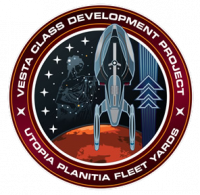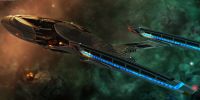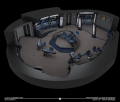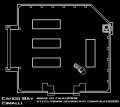Vesta Class
| STARSHIP | |
|---|---|
 | |
| Class | Vesta Class Explorer |
| Allegiance | United Federation of Planets |
 | |
 | |
| Specifications | |
| Type: | Explorer |
| Length: | 670 Meters |
| Beam: | 195 Meters |
| Height: | 88 Meters |
| Mass: | 3,321,630 metric tons |
| Decks: | 19 Deck Plans |
| Crew Compliment: | Standard: 115 Officers, 485 Enlisted Crew Breakdown Emergency: 2,000 |
| Warp Speed: | Type: Cruise Speed: Warp 8 Sustainable Speed: Warp 9.8 Emergency Speed: Warp 9.99 (36 hour automatic shutdown) |
| Impulse Engines: | Type: 2 Class 8 Main Impulse Engines (MIE), 2 Secondary Impulse Engines (SIE) Speed: .87 C |
| Other Propulsion Systems: | Type-1 Quantum Slipstream Generator Speed: Warp 9.99998477 (12 hour automatic shutdown) |
| Defensive Systems: | Type-1A Shield generator |
| Other Defensive Systems: | Sensor Cloak, 20cm Ablative Armour |
| Armament: | Phasers: 2x Type XII Phaser Cannons (Saucer - Forward); 2x 140-degree Type-XII Arrays, one starboard, one port (Saucer - Dorsal); 2x 90-degree Type-XII Arrays, one starboard, one port (Saucer - Ventral); |
| Other Capabilities: | Planet Landing Capabilities - Blue Alert |
| Computer System: | Yori-Moto D4D019 |
| Tractor/Repulsor: | 2 Main Tractor/Repulsor Beams, 5 Shuttle Docking Tractors (4 in Main Bay, 1 for Yacht), 6 Docking Tractors |
| Shuttlecraft: | 1 Bay (A), 10 Shuttles (4 Type 12, 4 Type 14, 2 Type 17), 2 Runabouts (Delta Class) |
| Sensors: | SS Sierra 1a8 Deep Space Scientific Sensors Daystrom Industries HSCS-3SC-A Starship Sensors |
The Vesta-class Explorer is a Star Fleet starship class, of Explorer type in use from 2419.
History
Originally conceived as a deep-space Explorer and Reconnaissance Vessel in the early 2380s, the Vesta-class was beset by technical issues and ultimately suspended as the First General War loomed. The project was revived as part of the Fleet Modernization Program in 2417, intended to supplement the new Beckett Class and replace the ageing and increasingly maintenance-heavy Avenger and Zeus classes as a middleweight explorer that combined the strengths of both vessels and go some way to negate the glaring weaknesses in the previous design; which had been built as warships first, and explorers second.
The earliest ships in the class would also serve as testbeds for new technologies, including Holographic Displays, a Multidimensional Wave-function Analysis Module, and Quantum Slipstream Drive; the latter having finally been deemed viable forty years following the concept's initial transmission from the ill-fated USS Voyager. Additionally, the computer system also features an holographic avatar with limited artificial intelligence that is designed to replace the computer's traditional interactive mode. This avatar does not replace the computer, and only responds when called by name. The avatar cannot be physically interacted with, and projectors are only mounted in command and control areas, the only exception being Sickbay, where the avatar also acts as the vessel's Emergency Medical Hologram.
The Vesta-class also boasts an expansive Shuttlebay, capable of holding eight Shuttles and a Runabout, with an expanded area to accommodate larger vessels such as Captain's Yachts or Support Escorts. This also allows for a further eight Shuttles or six Runabouts may be carried; allowing the Vesta to act as a "pocket carrier" in emergency situations such as planetary disasters.
Like the Beckett-class, the Vesta-class differed from its forebears by returning to a predominantly Array-based Phaser system, creating greater coverage of fire. The number of Torpedo Launchers was reduced to four, but technological advances allowed these tubes to rapid-fire torpedoes rather than being forced to risk "stacking" them in the launch chamber. The final addition was the inclusion of two Type-G cannons in the ship's bow, the multi-function weapons enabling the ship to destroy incoming torpedoes, while also granting it the firepower to punch through any blockade with ease.
The prototype vessel, the USS Vesta, EX-10000, was launched in September 2418. The trials were successful but highlighted some failings in the design, though relatively minor compared to those found in the Beckett. These flaws had been mostly ironed out by early 2419, and the first production model is expected to launch soon.
Internal Layout
Deck One
Crew Areas
Operational Areas
Vessels
| Name | Registry | Launched | Status |
|---|---|---|---|
| USS Vesta | EX-10000 | 21809.01 | Prototype - Systems Testbed |
| USS Artemis | EX-11000 | 21903.01 | Active |
| USS Athena | EX-11001 | 2419 | Active |
| USS Nike | EX-11002 | 2420 | Fitting Out |
| USS Freyja | EX-11003 | 2420 | Fitting Out |
| USS Astraea | EX-11004 | 2421 | Under Construction |
| USS Demeter | EX-11005 | 2421 | Under Construction |











